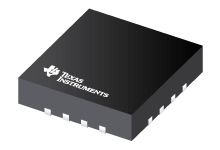Datasheet Texas Instruments TPS61090RSAR
| Manufacturer | Texas Instruments |
| Series | TPS61090 |
| Part Number | TPS61090RSAR |

2A Switch, 96% Efficient Boost Converter 16-QFN -40 to 85
Datasheets
TPS6109x Synchronous Boost Converter With 2-A Switch datasheet
PDF, 1.0 Mb, Revision: C, File published: Dec 24, 2014
Extract from the document
Prices
Status
| Lifecycle Status | Active (Recommended for new designs) |
| Manufacture's Sample Availability | Yes |
Packaging
| Pin | 16 | 16 |
| Package Type | RSA | RSA |
| Industry STD Term | VQFN | VQFN |
| JEDEC Code | S-PQFP-N | S-PQFP-N |
| Package QTY | 3000 | 3000 |
| Carrier | LARGE T&R | LARGE T&R |
| Device Marking | 1090 | TPS6 |
| Width (mm) | 4 | 4 |
| Length (mm) | 4 | 4 |
| Thickness (mm) | .9 | .9 |
| Pitch (mm) | .65 | .65 |
| Max Height (mm) | 1 | 1 |
| Mechanical Data | Download | Download |
Parametrics
| Duty Cycle(Max) | 100 % |
| Iq(Typ) | 0.02 mA |
| Operating Temperature Range | -40 to 85 C |
| Package Group | QFN |
| Rating | Catalog |
| Regulated Outputs | 1 |
| Special Features | Enable,Frequency Synchronization,Light Load Efficiency,Load Disconnect,Power Good |
| Switch Current Limit(Min) | 2 A |
| Switch Current Limit(Typ) | 2 A |
| Switching Frequency(Max) | 700 kHz |
| Switching Frequency(Min) | 500 kHz |
| Type | Converter |
| Vin(Max) | 5.5 V |
| Vin(Min) | 1.8 V |
| Vout(Max) | 5.5 V |
| Vout(Min) | 1.8 V |
Eco Plan
| RoHS | Compliant |
Design Kits & Evaluation Modules
- Evaluation Modules & Boards: TPS61090EVM-029
TPS61090 Evaluation Module
Lifecycle Status: Active (Recommended for new designs) - Evaluation Modules & Boards: TPS61070EVM-062
TPS61070 Evaluation Module
Lifecycle Status: Active (Recommended for new designs)
Application Notes
- Powering a White LED Flashlight with the TPS61090PDF, 74 Kb, File published: May 23, 2005
This application report details how to drive a 3-W white LED from a single lithium-ion battery using the Texas Instruments TPS61090 low-power dc-dc boost converter to achieve efficiencies >90%. Design considerations and equations needed for driving a single, multiple-watt white LED are covered including efficiency improvements, peak switch current calculations, and a soft-start considerations. - Automated Frequency Response AnalyzerPDF, 939 Kb, File published: Oct 9, 2013
This application report discusses a new method of doing stability Analysis testing by using basic labequipment, while not requiring any specific instruments. - Five Steps to a Good PCB Layout of the Boost ConverterPDF, 701 Kb, File published: May 3, 2016
- Minimizing Ringing at the Switch Node of a Boost ConverterPDF, 201 Kb, File published: Sep 15, 2006
The application report explains how to use proper board layout and/or a snubber to reduce high-frequency ringing at the switch node of a boost converter. - Design considerations for a resistive feedback divider in a DC/DC converterPDF, 393 Kb, File published: Apr 26, 2012
- Basic Calculation of a Boost Converter's Power Stage (Rev. C)PDF, 186 Kb, Revision: C, File published: Jan 8, 2014
This application note gives the equations to calculate the power stage of a boost converter built with an IC with integrated switch and operating in continuous conduction mode. It is not intended to give details on the functionality of a boost converter (see Reference 1) or how to compensate a converter. See the references at the end of this document if more detail is needed. - Optimizing Transient Response of Internally Compensated DC-DC Converters (Rev. A)PDF, 1.1 Mb, Revision: A, File published: May 11, 2015
- Extending the Soft Start Time Without a Soft Start Pin (Rev. B)PDF, 387 Kb, Revision: B, File published: Jun 15, 2017
- Choosing an Appropriate Pull-up/Pull-down Resistor for Open Drain OutputsPDF, 130 Kb, File published: Sep 19, 2011
- QFN and SON PCB Attachment (Rev. B)PDF, 821 Kb, Revision: B, File published: Aug 24, 2018
- IQ: What it is what it isn’t and how to use itPDF, 198 Kb, File published: Jun 17, 2011
- Performing Accurate PFM Mode Efficiency Measurements (Rev. A)PDF, 418 Kb, Revision: A, File published: Dec 11, 2018
When performing measurements on DC-DC converters using pulse frequency modulation(PFM)or any power save mode proper care must be taken to ensure that the measurements are accurate. An accurate PFM mode efficiency measurement is critical for systems which require high efficiency at low loads such as in smart home systems tablets wearables and metering.
Model Line
Series: TPS61090 (2)
- TPS61090RSAR TPS61090RSARG4
Manufacturer's Classification
- Semiconductors > Power Management > Non-isolated DC/DC Switching Regulator > Step-Up (Boost) > Boost Converter (Integrated Switch)
